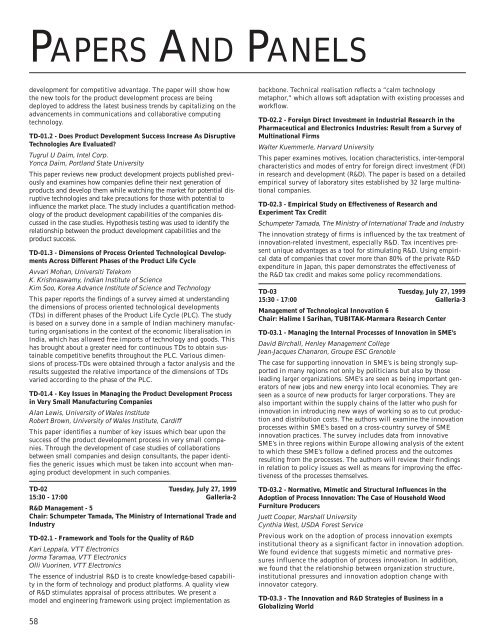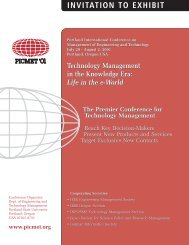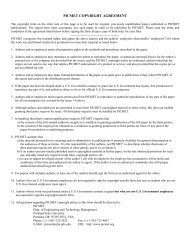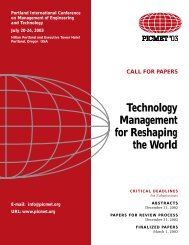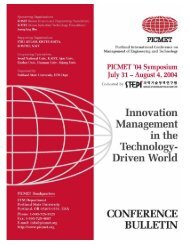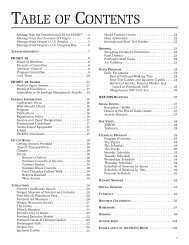Technology & Innovation Management: - PICMET Conference
Technology & Innovation Management: - PICMET Conference
Technology & Innovation Management: - PICMET Conference
Create successful ePaper yourself
Turn your PDF publications into a flip-book with our unique Google optimized e-Paper software.
PAPERS AND PANELS<br />
development for competitive advantage. The paper will show how<br />
the new tools for the product development process are being<br />
deployed to address the latest business trends by capitalizing on the<br />
advancements in communications and collaborative computing<br />
technology.<br />
TD-01.2 - Does Product Development Success Increase As Disruptive<br />
Technologies Are Evaluated?<br />
Tugrul U Daim, Intel Corp.<br />
Yonca Daim, Portland State University<br />
This paper reviews new product development projects published previously<br />
and examines how companies define their next generation of<br />
products and develop them while watching the market for potential disruptive<br />
technologies and take precautions for those with potential to<br />
influence the market place. The study includes a quantification methodology<br />
of the product development capabilities of the companies discussed<br />
in the case studies. Hypothesis testing was used to identify the<br />
relationship between the product development capabilities and the<br />
product success.<br />
TD-01.3 - Dimensions of Process Oriented Technological Developments<br />
Across Different Phases of the Product Life Cycle<br />
Avvari Mohan, Universiti Telekom<br />
K. Krishnaswamy, Indian Institute of Science<br />
Kim Soo, Korea Advance Institute of Science and <strong>Technology</strong><br />
This paper reports the findings of a survey aimed at understanding<br />
the dimensions of process oriented technological developments<br />
(TDs) in different phases of the Product Life Cycle (PLC). The study<br />
is based on a survey done in a sample of Indian machinery manufacturing<br />
organisations in the context of the economic liberalisation in<br />
India, which has allowed free imports of technology and goods. This<br />
has brought about a greater need for continuous TDs to obtain sustainable<br />
competitive benefits throughout the PLC. Various dimensions<br />
of process-TDs were obtained through a factor analysis and the<br />
results suggested the relative importance of the dimensions of TDs<br />
varied according to the phase of the PLC.<br />
TD-01.4 - Key Issues in Managing the Product Development Process<br />
in Very Small Manufacturing Companies<br />
Alan Lewis, University of Wales Institute<br />
Robert Brown, University of Wales Institute, Cardiff<br />
This paper identifies a number of key issues which bear upon the<br />
success of the product development process in very small companies.<br />
Through the development of case studies of collaborations<br />
between small companies and design consultants, the paper identifies<br />
the generic issues which must be taken into account when managing<br />
product development in such companies.<br />
TD-02 Tuesday, July 27, 1999<br />
15:30 - 17:00 Galleria-2<br />
R&D <strong>Management</strong> - 5<br />
Chair: Schumpeter Tamada, The Ministry of International Trade and<br />
Industry<br />
TD-02.1 - Framework and Tools for the Quality of R&D<br />
Kari Leppala, VTT Electronics<br />
Jorma Taramaa, VTT Electronics<br />
Olli Vuorinen, VTT Electronics<br />
The essence of industrial R&D is to create knowledge-based capability<br />
in the form of technology and product platforms. A quality view<br />
of R&D stimulates appraisal of process attributes. We present a<br />
model and engineering framework using project implementation as<br />
backbone. Technical realisation reflects a “calm technology<br />
metaphor,” which allows soft adaptation with existing processes and<br />
workflow.<br />
TD-02.2 - Foreign Direct Investment in Industrial Research in the<br />
Pharmaceutical and Electronics Industries: Result from a Survey of<br />
Multinational Firms<br />
Walter Kuemmerle, Harvard University<br />
This paper examines motives, location characteristics, inter-temporal<br />
characteristics and modes of entry for foreign direct investment (FDI)<br />
in research and development (R&D). The paper is based on a detailed<br />
empirical survey of laboratory sites established by 32 large multinational<br />
companies.<br />
TD-02.3 - Empirical Study on Effectiveness of Research and<br />
Experiment Tax Credit<br />
Schumpeter Tamada, The Ministry of International Trade and Industry<br />
The innovation strategy of firms is influenced by the tax treatment of<br />
innovation-related investment, especially R&D. Tax incentives present<br />
unique advantages as a tool for stimulating R&D. Using empirical<br />
data of companies that cover more than 80% of the private R&D<br />
expenditure in Japan, this paper demonstrates the effectiveness of<br />
the R&D tax credit and makes some policy recommendations.<br />
TD-03 Tuesday, July 27, 1999<br />
15:30 - 17:00 Galleria-3<br />
<strong>Management</strong> of Technological <strong>Innovation</strong> 6<br />
Chair: Halime I Sarihan, TUBITAK-Marmara Research Center<br />
TD-03.1 - Managing the Internal Processes of <strong>Innovation</strong> in SME’s<br />
David Birchall, Henley <strong>Management</strong> College<br />
Jean-Jacques Chanaron, Groupe ESC Grenoble<br />
The case for supporting innovation in SME’s is being strongly supported<br />
in many regions not only by politicians but also by those<br />
leading larger organizations. SME’s are seen as being important generators<br />
of new jobs and new energy into local economies. They are<br />
seen as a source of new products for larger corporations. They are<br />
also important within the supply chains of the latter who push for<br />
innovation in introducing new ways of working so as to cut production<br />
and distribution costs. The authors will examine the innovation<br />
processes within SME’s based on a cross-country survey of SME<br />
innovation practices. The survey includes data from innovative<br />
SME’s in three regions within Europe allowing analysis of the extent<br />
to which these SME’s follow a defined process and the outcomes<br />
resulting from the processes. The authors will review their findings<br />
in relation to policy issues as well as means for improving the effectiveness<br />
of the processes themselves.<br />
TD-03.2 - Normative, Mimetic and Structural Influences in the<br />
Adoption of Process <strong>Innovation</strong>: The Case of Household Wood<br />
Furniture Producers<br />
Juett Cooper, Marshall University<br />
Cynthia West, USDA Forest Service<br />
Previous work on the adoption of process innovation exempts<br />
institutional theory as a significant factor in innovation adoption.<br />
We found evidence that suggests mimetic and normative pressures<br />
influence the adoption of process innovation. In addition,<br />
we found that the relationship between organization structure,<br />
institutional pressures and innovation adoption change with<br />
innovator category.<br />
TD-03.3 - The <strong>Innovation</strong> and R&D Strategies of Business in a<br />
Globalizing World<br />
58


